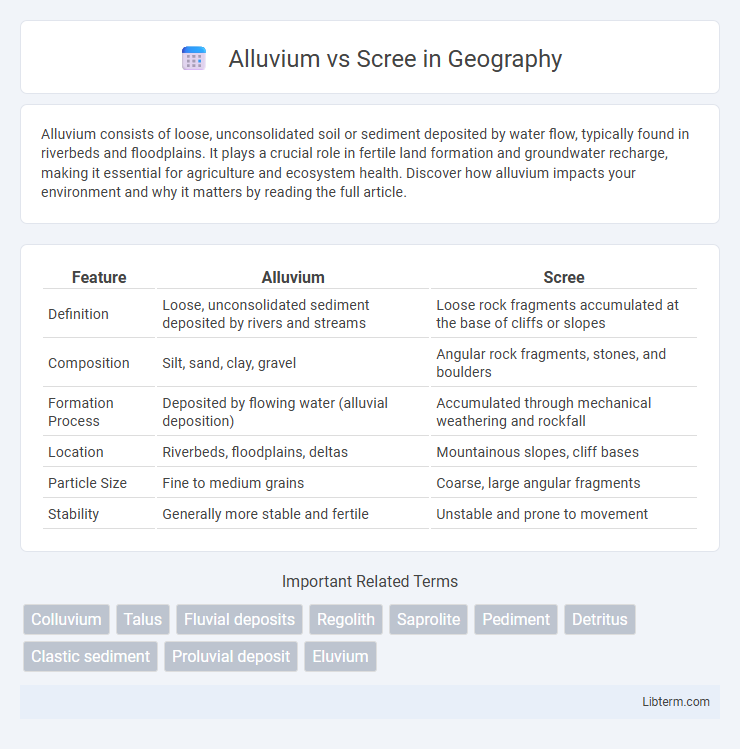Alluvium consists of loose, unconsolidated soil or sediment deposited by water flow, typically found in riverbeds and floodplains. It plays a crucial role in fertile land formation and groundwater recharge, making it essential for agriculture and ecosystem health. Discover how alluvium impacts your environment and why it matters by reading the full article.
Table of Comparison
| Feature | Alluvium | Scree |
|---|---|---|
| Definition | Loose, unconsolidated sediment deposited by rivers and streams | Loose rock fragments accumulated at the base of cliffs or slopes |
| Composition | Silt, sand, clay, gravel | Angular rock fragments, stones, and boulders |
| Formation Process | Deposited by flowing water (alluvial deposition) | Accumulated through mechanical weathering and rockfall |
| Location | Riverbeds, floodplains, deltas | Mountainous slopes, cliff bases |
| Particle Size | Fine to medium grains | Coarse, large angular fragments |
| Stability | Generally more stable and fertile | Unstable and prone to movement |
Introduction to Alluvium and Scree
Alluvium consists of loose, unconsolidated sediments such as sand, silt, clay, and gravel deposited by running water, typically found in riverbeds, floodplains, and deltas. Scree, also known as talus, is composed of angular rock fragments accumulated at the base of cliffs or steep slopes through processes like frost wedging and rockfall. These geomorphological deposits differ significantly in origin and particle characteristics, impacting soil formation and landscape evolution.
Definition of Alluvium
Alluvium is a geological term referring to loose, unconsolidated soil or sediments, such as sand, silt, clay, and gravel, that have been deposited by running water, typically in riverbeds, floodplains, or deltas. These deposits are often rich in nutrients and play a crucial role in agricultural fertility and ecosystem support. In contrast, scree consists of angular rock fragments that accumulate at the base of cliffs or steep slopes, formed primarily through physical weathering without the influence of water transportation.
Definition of Scree
Scree refers to a slope covered with loose, broken rock fragments, typically found at the base of cliffs or steep rocky areas, formed through the processes of weathering and erosion. Unlike alluvium, which consists of fine-grained sediment deposited by flowing water, scree is characterized by coarse, angular debris that accumulates through physical disintegration of rock. This distinction highlights scree's origin from mechanical breakdown rather than sedimentary transport.
Formation Processes of Alluvium
Alluvium forms through the deposition of sediments by flowing water, typically in riverbeds, floodplains, and deltas, where fine particles such as silt, sand, clay, and gravel accumulate over time. This process contrasts with scree, which consists of loose, angular rock fragments that accumulate at the base of cliffs due to mechanical weathering and rockfall. The continuous movement and sorting by water result in the well-rounded, stratified nature of alluvium, influencing soil fertility and landscape development.
Formation Processes of Scree
Scree forms through mechanical weathering, primarily frost wedging, where water infiltrates cracks in rock, freezes, expands, and breaks the rock into loose fragments. The resulting angular debris accumulates at the base of cliffs or steep slopes, shaped by gravity-driven processes such as rockfall and landslides. In contrast, alluvium consists of finer sediments like silt, sand, and clay, transported and deposited by flowing water in riverbeds and floodplains.
Key Differences Between Alluvium and Scree
Alluvium consists of fine, water-deposited sediments such as sand, silt, and clay found primarily in riverbeds and floodplains, while scree comprises loose, angular rock fragments that accumulate at the base of cliffs through physical weathering processes. Alluvium typically forms well-sorted, layered deposits conducive to fertile soil development, whereas scree is characterized by poorly sorted, unstable rock debris that lacks significant soil formation. Understanding these differences is crucial for geology, soil science, and land use planning where sediment composition affects erosion, vegetation, and construction stability.
Environmental Significance of Alluvium
Alluvium, comprised of fine sediments like silt, sand, and clay deposited by flowing water, plays a critical role in forming fertile floodplains and sustaining diverse ecosystems. It supports agriculture by enriching soil fertility and replenishing groundwater resources vital for plant and animal life. In contrast, scree consists of loose, angular rock fragments typically found on steep slopes, offering limited environmental benefits compared to the nutrient-rich and moisture-retentive properties of alluvium deposits.
Geological Importance of Scree
Scree, composed of loose rock fragments at the base of cliffs, plays a crucial geological role in landscape evolution by influencing erosion and sediment transport processes. Unlike alluvium, which consists of finer sediment deposited by water, scree contributes to slope stability and acts as a source of coarse material in mountainous environments. Its accumulation patterns help geologists interpret past climatic conditions and tectonic activity, making scree essential for understanding geomorphological dynamics.
Common Locations and Examples
Alluvium typically accumulates in riverbeds, floodplains, and deltas, with common examples including the Nile Delta in Egypt and the Mississippi River Basin in the United States. Scree forms on steep slopes and at the base of cliffs, frequently found in mountainous regions such as the Scottish Highlands and the Rocky Mountains in North America. Both deposits reveal distinctive geological settings where alluvium indicates water-driven sediment transport, while scree results from physical weathering and gravity-driven rockfall.
Conclusion: Choosing Between Alluvium and Scree in Earth Sciences
Choosing between alluvium and scree depends on the specific geological context and project needs. Alluvium, composed of fine sediments deposited by water, is ideal for soil fertility and groundwater studies, while scree, consisting of coarse rock fragments from mechanical weathering, is more relevant for slope stability and erosion analysis. Understanding their formation processes and physical characteristics guides accurate environmental and engineering assessments in earth sciences.
Alluvium Infographic

 libterm.com
libterm.com